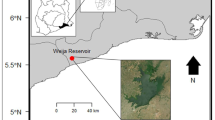Abstract
In this study, concentrations of Cd, Co, Cu, Ni, Pb, Fe, and Hg were determined in commercially valuable fish from Khuzestan shore, northwest of the Persian Gulf. It was also our intention to evaluate potential risks to human health associated with seafood consumption. The liver and skin showed higher metal concentrations than the muscle. The results showed that heavy metal concentrations in different food habitats increase in the following order: benthic omnivorous fish < zooplanktivore fish < phytoplanktivore fish < piscivore fish. Also, the comparison indicated that benthic species (Euryglossa orientalis, Otolithes ruber) were more contaminated than pelagic species (Liza abu and Psettodes erumei). Therefore, the concentration of heavy metals in edible part of fish species did not exceed the permissible limits proposed by Food and Agriculture Organization (FAO) (1983), WHO (1996), Regional Organization for the Protection of the Marine Environment (ROPME) (1999), and FAD (2001) which are suitable for human consumption, except for Ni and Cd in E. orientalis and Pb in O. ruber.
Similar content being viewed by others
References
Abdolahpur Monikh, F., Safahieh, A. R., Savari, A., & Doraghi, A. (2012). Heavy metal concentration in sediment, benthic, benthopelagic, and pelagic fish species from Musa Estuary (Persian Gulf). Environmental Monitoring and Assessment. doi:10.1007/s10661-012-2545-9.
Agah, H., Leermakers, M., Elskens, M., Fatemi, S. M. R., & Baeyens, W. (2009). Accumulation of trace metals in the muscle and liver tissues of five fish species from the Persian Gulf. Environmental Monitoring and Assessment, 157, 499–514.
Bustamante, P., Bocher, P., Cherel, Y., Miramand, P., & Caurant, F. (2003). Distribution of trace elements in the tissues of benthic and pelagic fish from the Kerguelen Islands. The Science of the Total Environment, 313, 25–39.
Dalman, O., Demirak, A., & Balci, A. (2006). Determination of heavy metals (Cd, Pb) and trace elements (Cu, Zn) in sediments and fish of the southeastern Aegean Sea (Turkey) by atomic absorption spectrometry. Food Chemistry, 95, 157–162.
De Mora, S., Fowler, S., Wyse, E., & Azemard, S. (2004). Distribution of heavy metals in marine bivalves, fish and coastal sediments in Persian Gulf and Gulf of Oman. Marine Pollution Bulletin, 49, 410–424.
Demirak, A., Yilmaz, F., Tuna, L., & Ozdemir, N. (2006). Heavy metals in water, sediment and tissues of Leuciscus cephalus from a stream in southwestern Turkey. Chemosphere, 63, 1451–1458.
EC (European Commission) (2001). Council Directive 91/493/EEC of 22 July 1991 laying down the health conditions for the production and the placing on the market of fishery products. Official Journal of the European Communities, L 268, 0015–0034 (24/09/1991).
FAO (Food and Agriculture Organization) (1983). Compilation of legal limits for hazardous substances in fish and fishery products. FAO Fishery Circular No. 464 (pp. 5–10). Rome: Food and Agriculture Organization of the United Nations.
FAO (Food and Agriculture Organization) (2000). Compilation of legal limits for hazardous substances in fish and fishery products. FAO Fishery Circular No. 464 (pp. 5–10). Rome Food and Agriculture Organization of the United Nations.
FDA (2001). Fish and fisheries products hazards and controls guidance, 3rd edn. USA: Center for Food Safety and Applied Nutrition, US Food and Drug Administration.
Navarro, M. C., Perez-Sirvent, C., Martınez-Sanchez, M. J., Vidal, J., & Marimon, J. (2006). Lead, cadmium and arsenic bioavailability in the abandoned mine site of Cabezo Rajao (Murcia, SE Spain). Chemosphere, 63, 484–489.
NOAA (National Oceanic and Atmospheric Administration) (2009). Guidelines for consumer of sea food, vol. 2, 2nd ed., (pp. 45–211). USA.
Pourang, N., Nikouyan, A., & Dennis, J. H. (2005). Trace element concentrations in fish, surficial sediments and water from northern part of the Persian Gulf. Environmental Monitoring and Assessment, 109, 293–316.
Romeo, M., Siau, Y., Sidoumou, Z., & Gnassia-Barelli, M. (1999). Heavy metal distribution in different fish species from the Mauritania coast. The Science of the Total Environment, 232, 169–175.
ROPME (1999). Regional report of the state of the marine environment (p. 220). Kuwait: Regional Organization for the Protection of the Marine Environment (ROPME).
Sankar, T. V., Zynudheen, A. A., Anandan, R., & Viswanathan-Nair, P. G. (2006). Distribution of organochlorine pesticides and heavy metal residues in fish and shellfish from Calicut region, Kerala, India. Chemosphere, 65, 583–590.
Sen, A., & Semiz, A. (2007). Effects of metals and detergents on biotransformation and detoxification enzymes of leaping mullet (Liza saliens). Ecotoxicology and Environmental Safety, 68, 405–411.
Turkmen, A., Turkmen, M., Tepe, Y. I., & Akyurt, I. (2005). Heavy metals in three commercially valuable fish species from Iskenderun Bay, Northern East Mediterranean Sea, Turkey. Food Chemistry, 91, 167–172.
Tuzen, M. (2009). Toxic and essential trace elemental contents in fish species from the Black Sea, Turkey. Food and Chemical Toxicology, 47, 1785–1790.
WHO (World Health Organization) (1996). Health criteria other supporting information. In Guidelines for drinking water quality, vol. 2, 2nd edn., (pp. 31–388), Geneva.
WHO (World Health Organization) (2000). Health criteria other supporting information. In Guidelines for Drinking Water Quality, vol. 2, 2nd ed., (pp. 31–388), Geneva.
Yi, Y., Wang, Z., Zhang, K., Yu, G., & Duan, X. (2008). Sediment pollution and its effect on fish through food chain in the Yangtze River. International Journal of Sediment Research, 23, 338–347.
Yılmaz, A. B., & Yılmaz, L. (2007). Influences of sex and seasons on levels of heavy metals in tissues of green tiger shrimp (Penaeus semisulcatus de Hann, 1844). Food Chemistry, 101, 1664.
Acknowledgments
Special thanks are due to Dr. Bahram Hasanzadeh Kiabi for his help with statistical analysis and Ali Mansoori for his field assistance. This work was funded by the Khorramshahr University of Marine Science and Technology and Environment Protection Institute of Tehran, Iran.
Author information
Authors and Affiliations
Corresponding author
Rights and permissions
About this article
Cite this article
Hosseini, M., Nabavi, S.M.B., Nabavi, S.N. et al. Heavy metals (Cd, Co, Cu, Ni, Pb, Fe, and Hg) content in four fish commonly consumed in Iran: risk assessment for the consumers. Environ Monit Assess 187, 237 (2015). https://doi.org/10.1007/s10661-015-4464-z
Received:
Accepted:
Published:
DOI: https://doi.org/10.1007/s10661-015-4464-z




